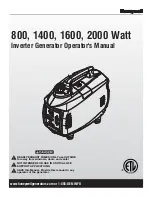
6
4300-00
60706-244
INSTALLATION
****************
***** WARNING *****
****************
PERSONAL INJURY - Before proceeding with the installation,
be sure the operation selector switch is in the “stop” position.
General Information
Note: Side panels are equipped with door latches for their
removal. All the door latches are keyed with a common key.
These engine generator sets are for outdoor installation. These
units must be bolted solidly to a concrete pad. The transfer
switch is mounted next to your distribution panel inside the
building. Consult a qualifi ed, licensed electrician or contractor to
install and wire the transfer switch. The installation must always
comply with all national, state, and local codes.
***** CAUTION *****
EQUIPMENT DAMAGE - These units must be mounted on a
solid concrete pad to prevent air from exiting under the unit.
Allowing air to exit under the unit may cause the unit to overheat
from lack of proper air fl ow.
Before beginning the installation process recheck the rating
of the generator set and its transfer switch rating. Be certain
they can handle the intended load and are compatible with
the entrance voltage, phase and current ratings. Plans
for installation should be prepared with proper attention to
mechanical and electrical engineering detail to assure a
satisfactory system installation. The information in this manual
is offered only as a guide to fi nalizing your installation plans. For
full service switching the A.T.S. must have a fusible disconnect
(circuit breaker) installed before the switch to protect the
contacts.
ENGINE GENERATOR SET MOUNTING
The unit’s main frame should be bolted solidly to a 4 to 6 inch
thick cement pad. The engine-generator is mounted on a sub-
frame which is attached with special shock mounts to the main
frame. This allows the engine-generator free movement without
affecting the control panel which is mounted on the main frame.
Do not shock mount the main frame. Engine vibration will be
transmitted to the control panel causing erroneous start/stop
cycles and premature control failure.
These units should be mounted a minimum of 24” from a
structure. This will allow for ample room to maintain and work
on the generator set. Units must be installed in accordance with
all local, state, and national codes. Consult your local agency
having jurisdiction for specifi c requirements.
FUEL INSTALLATION
The fuel supply should be as close as possible to the engine.
This will reduce the installation cost of fuel runs. The information
in this manual is offered to assist you in providing the proper fuel
for your engine. However, this information is only provided to
inform you of the engine’s requirements and assist in making you
aware of the decisions you must make. In no case should the
instructions or information provided be interpreted to confl ict with
any local, state or national codes. If in doubt, always consult
your local fi re marshal or gas supplier.
****************
***** WARNING *****
****************
FIRE HAZARD - All fuel runs should be installed by a licensed
fuel supplier.
Connect the fuel supply to the inlet of the fuel solenoid (see
table for recommended line size). The pressure at the demand
regulator must be four to six ounces per square inch or 7 to 11
inches W.C. (Water column) on vapor withdrawal units. On units
equipped with liquid withdrawal fuel systems full tank pressure
is plumbed to the fuellock strainer mounted on the generator
rails. The fuel converter mounted on the unit will handle both
vaporization of the fuel and pressure reduction.
INSTALLING THE FUEL LINE
** NOTICE **
The engine generator sets are properly adjusted before they
leave the factory for a specifi c fuel, either NG (natural gas), LP
(liquid propane vapor) or LPG (liquid withdrawal propane). This
fuel type is noted in your model number. If it becomes necessary
to change the fuel type in the fi eld see information on page 16.
Line Size (vapor system)
Unit location will determine the size of fuel line that is required
to supply the engine with a constant fuel pressure. Refer
to the tables below for fuel line size, fuel consumption and
recommended tank size. For distances of 25 feet and over, a
two regulator fuel system is recommended. This is accomplished
by installing a primary regulator at the tank which will reduce the
tank pressure down to 10 to 15 lbs. A secondary regulator is
installed to further reduce the fuel pressure to the required six (6)
oz operating pressure. This secondary regulator must be at least
10 feet from the engine generator set. Any closer installation
will require a larger line be installed to provide a fuel reservoir.
If this is not done, the demand regulator on the unit and the
pressure regulator in the fuel line will interfere with each other.
When this two (2) stage regulator system is used, a fuel line
size of 1 inch is generally adequate for distances up to 300 feet
from the primary to the secondary regulator. (Consult your local
fuel supplier for your exact requirements). The appropriate line
size from the table below is then installed from the secondary
regulator to the generator set.







































